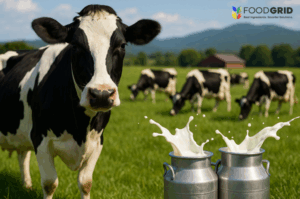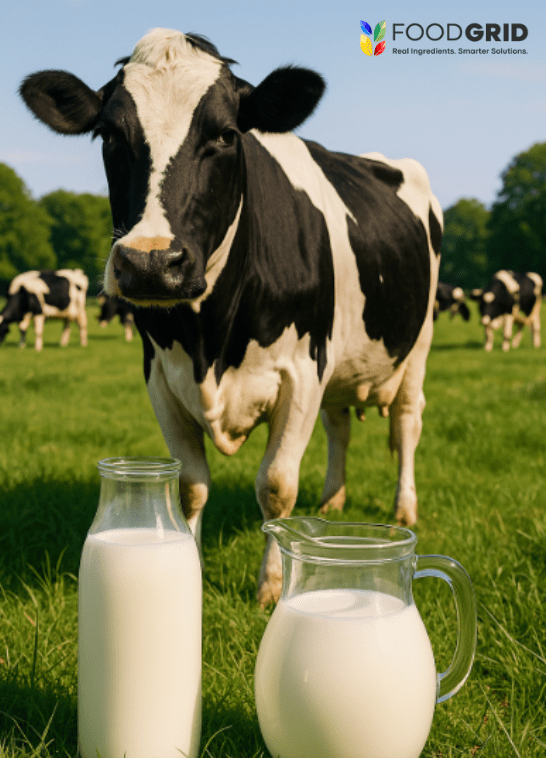As a herd nutritionist managing a 500-head plus operation, you know the cost of underperforming early lactation cows intimately: lost milk, suppressed fat, metabolic disorders, rising feed bills. What if you could reliably boost milk yield by 2-4 kg/day and fat content by up to 0.8% — by incorporating a well-researched calcium salt of fatty acids? The science, now more robust than ever, shows precisely how to deliver on that promise.
Introduction
In modern dairy operations, energy deficits in early lactation and variable rumen pH present significant challenges to achieving optimal milk and component production. Add to that regulatory pressure on antibiotic alternatives and the need for sustainable herd health, and it becomes clear: feed additives must deliver measurable results. One of the most dependable tools in the nutritionist’s toolkit is the inclusion of calcium salts of fatty acids (CSFA) — typically 3-6% of dry matter (DM) — in the ration. For professionals like you managing bulk additive contracts (1-ton pallets or more) for budgets in the $50K–$200K range, this isn’t a novelty — it’s a strategic choice. This blog reviews the up-to-date research on CSFAs in dairy cows, focusing on palmitic and oleic blends, dose-responses, performance outcomes, and practical inclusion strategies.
Why Calcium Salts of Fatty Acids Matter
Feed energy is a limiting factor in early lactation dairy cows, particularly when DM intake is depressed, and lipomobilization is triggered. Traditional fat sources often disrupt rumen fermentation or get biohydrogenated before offering benefit. CSFAs provide a rumen-protected lipid source that bypasses much of the rumen microbial hydrogenation, delivering fatty acids to the small intestine for absorption and metabolic utilisation. One foundational paper from the late 1980s showed that cows fed CSFAs improved production responses compared to non-fat supplemented controls. Journal of Dairy Science+2ScienceDirect+2 A meta-analysis by Santos and colleagues (Journal of Dairy Science) consolidated 38 trials (86 comparisons) and concluded that fat additions — especially CSFAs — increased milk yield and fat content. Journal of Dairy Science+1
For you as a dairy nutritionist, the benefits are clear: improved energy density without rumen upset; better yield and component performance; improved fat delivery. Let’s dig into the latest research specifics.
Recent Research Highlights
- Dose-Response of CSFAs
A 2022 study evaluated increasing levels of calcium salts of palm fatty acids (CSPF) in early-lactation dairy cows. They found dose-dependent improvements in nutrient digestibility and production responses. ScienceDirect Key take-aways:
- When CSFA is included at higher percentages of DM, milk yield and fat were improved versus control.
- Digestibility of neutral detergent fibre (NDF) and crude protein (CP) improved marginally, suggesting better nutrient utilisation.
- For operations seeking incremental gains, adjusting from 3% to 5% may provide measurable return — within your contract scope.
- Fatty Acid Profile Matters: Palmitic vs Oleic
A recent (2024) article in the Journal of Dairy Science reported that the ratio of palmitic acid (C16:0) to oleic acid (C18:1) in CSFAs significantly impacts digestibility and cow performance. ScienceDirect+1 Findings:
- Higher oleic proportions improved fat-corrected milk and milk fat yield more than high palmitic ratios in some cases.
- The saturated palmitic form has strong yield responses but may reduce digestibility relative to more oleic blends.
- For your budget and inclusion target (3-6% DM), choosing a supplier offering optimized palmitic/oleic ratios is essential to maximise ROI.
- Broad Meta-analysis of Palm-Fat CSFA
Another meta-analysis (2021) looked at CSPF across many dairy cow trials. They found consistent positive responses in milk yield and fat yield when CSFAs were used versus non-fat control diets. Journal of Dairy Science+1 Practical interpretation: the technology is proven — you’re not taking a chance.
- Beyond Milk: Metabolic and Reproductive Outcomes
While yield and fat are primary targets, several studies report metabolic benefits as well. For example, a 2025 open access study evaluated CSFA derived from linseed/fish oil (omega-3 rich) and found improved milk yield, protein yield and reproductive outcomes, without negative metabolic effects. MDPI For herd health and sustainability, that’s a valuable bonus.

Practical Performance Outcomes
For a mid-to-large dairy (500+ cows), here’s what you can reasonably expect when CSFAs are properly applied:
- Milk yield increase: Many trials show +1.5 to +4 kg/day per cow when CSFAs are included at ~3-6% DM and formulated correctly. Meta-analyses confirm this magnitude. Journal of Dairy Science+1
- Milk fat increase: Up to +0.5-0.8% milk fat content is realistic when CSFAs with favourable fatty acid profile are used. Site or herd specific variables (rumen pH, forage quality) will affect the top end of that range.
- Feed efficiency: Because CSFAs increase net energy intake without reducing DMI, feed conversion and energy balance improve. The 2025 study with omega-3 CSFAs showed better feed efficiency. MDPI
- Health & fertility: With better energy status and fat partitioning, metabolic disorders (ketosis, fatty liver) are reduced; reproductive performance may improve. The omega-3 CSFA trial saw improved pregnancy rate at 130 DIM. MDPI
- Sustainability & cost control: Higher milk yield and component recovery spread fixed costs and support profitability amid rising feed cost — the critical lever for your role.
Implementation Strategy for Your Herd
As a herd nutritionist with budget authority and bulk buying power, you can optimise CSFA inclusion with the following considerations:
Select the Right Product
- Ensure the product is a true calcium salt of fatty acids (as opposed to free oils or blended fats).
- Ask the supplier for the fatty acid profile: preferably a blend of palmitic and oleic acids (example: PA:OA 1:1 or slightly higher OA) as recent research indicates benefit.
- Verify rumen protection and pelleting/supply method (3-6% DM inclusion means 30-60 kg per tonne DM, depending on herd ration and size).
- Confirm product has been tested in lactating cows with documented ROI or peer-reviewed trials.
Diet Inclusion
- Target inclusion at 3-6% of DM. Many studies show solid returns in that interval.
- Introduce during early lactation (first 90–120 DIM) when energy deficit is highest; some trials extend through mid-lactation depending on herd strategy.
- Monitor rumen pH (ensure stable feeding, avoid large oil or free-fat loads). CSFAs minimise rumen disruption, but baseline rumen health must be maintained.
Monitor Metrics
- Track milk yield per cow, fat percentage, and fat yield.
- Calculate component income per cow to evaluate ROI (yield gain × milk/component value vs additive cost).
- Monitor body condition score (BCS), feed intake, and metabolic indicators (NEFA, BHBA) if available.
- Monitor reproductive performance (e.g., days to first service, pregnancy rate) as a secondary benefit.
Supplier & Contracting
- Work with bulk suppliers (e.g., one-ton pallets) and negotiate pricing tied to volume.
- Require documentation of product lot composition and guarantee of fatty acid profile.
- Consider contract terms that allow adjustments if fatty acid profile or rumen‐protection results are unsatisfactory.
Risk Management & Herd Health Integration
- CSFA is not a substitute for base ration quality — adequate forage, fibre, and rumen acid control are essential.
- If rumen pH is variable (low rumen buffers, frequent acidosis), mitigate that as priority; CSFAs perform best when rumen health is stable.
- Because antibiotic alternatives and herd health are under scrutiny, highlight the metabolic and health robustness associated with energy‐dense CSFAs.

Case Scenario: ROI Estimation
Let’s model a 1,000-cow herd that implements a CSFA product at 4% DM inclusion during the first 120 DIM of lactation. Assume each cow yields +3 kg/day for 120 days, and milk price is $0.35 per kg, fat content increases by 0.6% (milk price bonus $0.03/kg milk for fat uplift). Additive cost is $0.10 per cow per day.
- Yield gain revenue: 3 kg/day × 120 days × $0.35 = $126 per cow.
- Fat bonus: 3 kg/day × 0.006 rise × $0.03 = $0.54 per cow (simplified).
- Additive cost: $0.10/day × 120 days = $12 per cow.
- Net gain per cow: ~$114.
- For 1,000 cows: $114,000 net gain over the 120 days.
This ROI fits a budget of $50K-$200K additive spend — and underlines why your role is strategic.
Integration with Your Broader Nutrition Program
- Pair CSFAs with rumen‐protected fats and strategic energy density feeds — this supports early lactation energy deficits and helps curb metabolic disorders.
- Align CSFA use with your forage programme: ensure fibre, NDF digestibility, and rumen function are robust so the extra energy is absorbed and utilised.
- Incorporate CSFA tracking into your herd KPI dashboard: yield, fat %, metabolic health, reproduction.
- Leverage your additive contract to integrate training for the herd management team on feeding strategy, inclusion timing, and monitoring.
Takeaways for the Dairy Nutritionist
- CSFAs are evidence-based: numerous peer-reviewed studies and meta-analyses support yield and component improvements.
- The fatty acid profile (PA vs OA) and dose matter — selecting the right product and inclusion level is critical.
- For your budget and herd size, this is high-leverage intervention — strong yield returns, component bonuses, and herd health benefits.
- Implementation is not plug-and-play: diet design, rumen health, forage quality, and monitoring must align to unlock full benefit.
- Supplier contracting, product verification, and monitoring are essential parts of the strategy.
- Beyond yield and fat, CSFAs support energy balance and reproductive performance — helping with your objective of “sustainable herd health for long-term profitability.”
Internal Links & Further Resources
- To explore more about our company’s vision and product lines, visit our About page: FoodGrid Inc.
- For additional blog content related to feed additives and dairy nutrition, check our blog archive: FoodGrid FoodBlog
- If you’re interested in how we evaluate additive ROI and feeding programmes, contact our technical team via the “Contact Us” link on our site.
If you’re managing a mid-to-large dairy and looking to enhance milk yield, boost fat content, and strengthen herd energy balance in early lactation — let’s talk. Reach out to the team at FoodGrid Inc. today to review CSFA inclusion options, evaluate supplier partnerships, and integrate a performance‐based programme tailored to your herd. Maximise the return on your additive spend — and drive both productivity and profitability.
References
- Effects of the palmitic-to-oleic ratio in the form of calcium salts of fatty acids on nutrient digestibility and cow performance. Journal of Dairy Science. Journal of Dairy Science
- Increasing levels of calcium salts of palm fatty acids affect nutrient digestibility and production responses of early-lactation dairy cows. Journal of Dairy Science. ScienceDirect
- Effects of calcium salts of palm fatty acids: meta-analysis on nutrient digestibility and production responses. Journal of Dairy Science. Journal of Dairy Science+1
- Effects of feeding calcium salts from a mixture of linseed and fish oil on productive response, metabolic status, and reproductive parameters in early-lactation dairy cows. MDPI Dairy. MDPI
- Effect of fat additions to diets of dairy cattle on milk production and components: meta-analysis review. Journal of Dairy Science. Journal of Dairy Science+1
